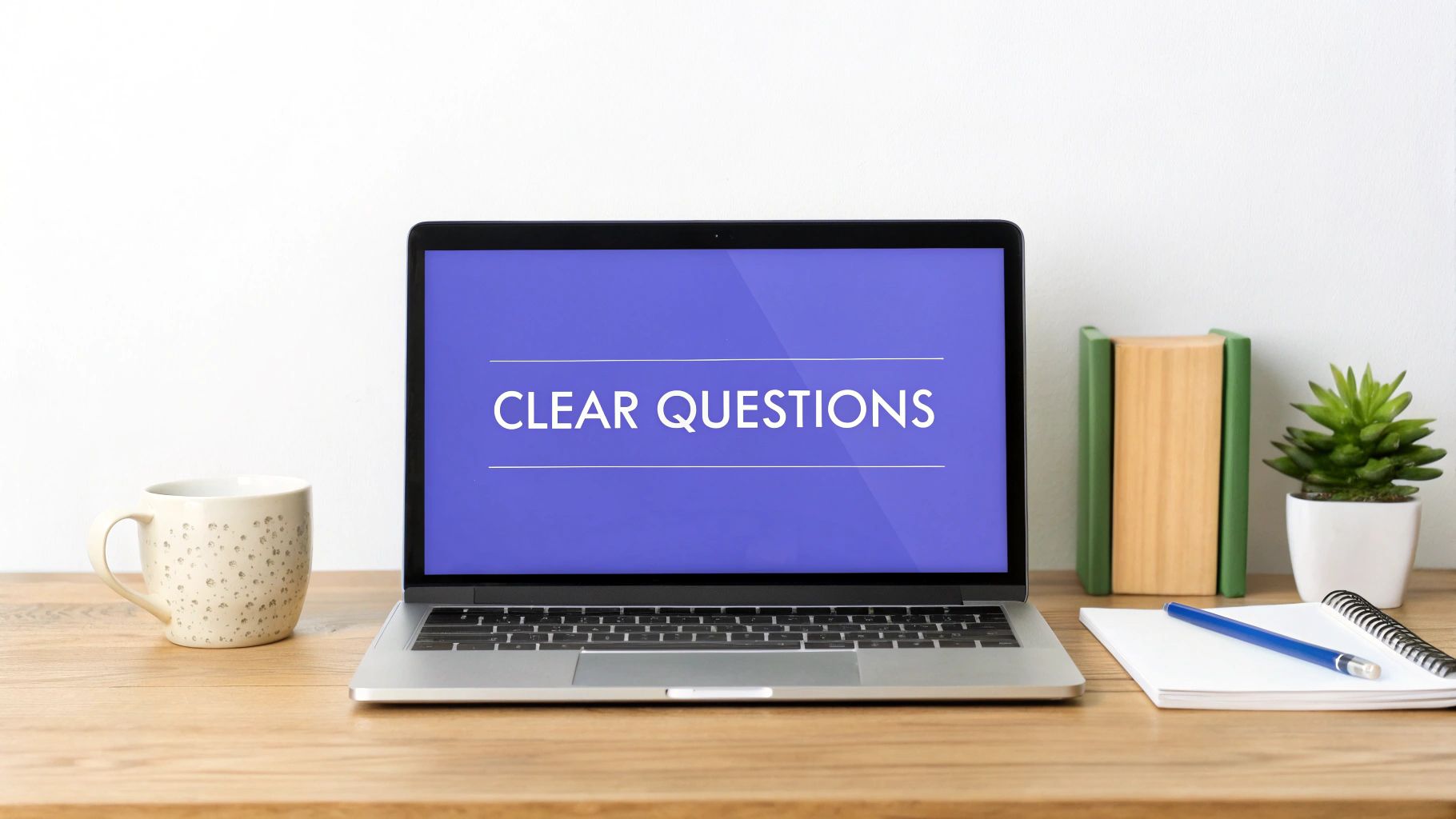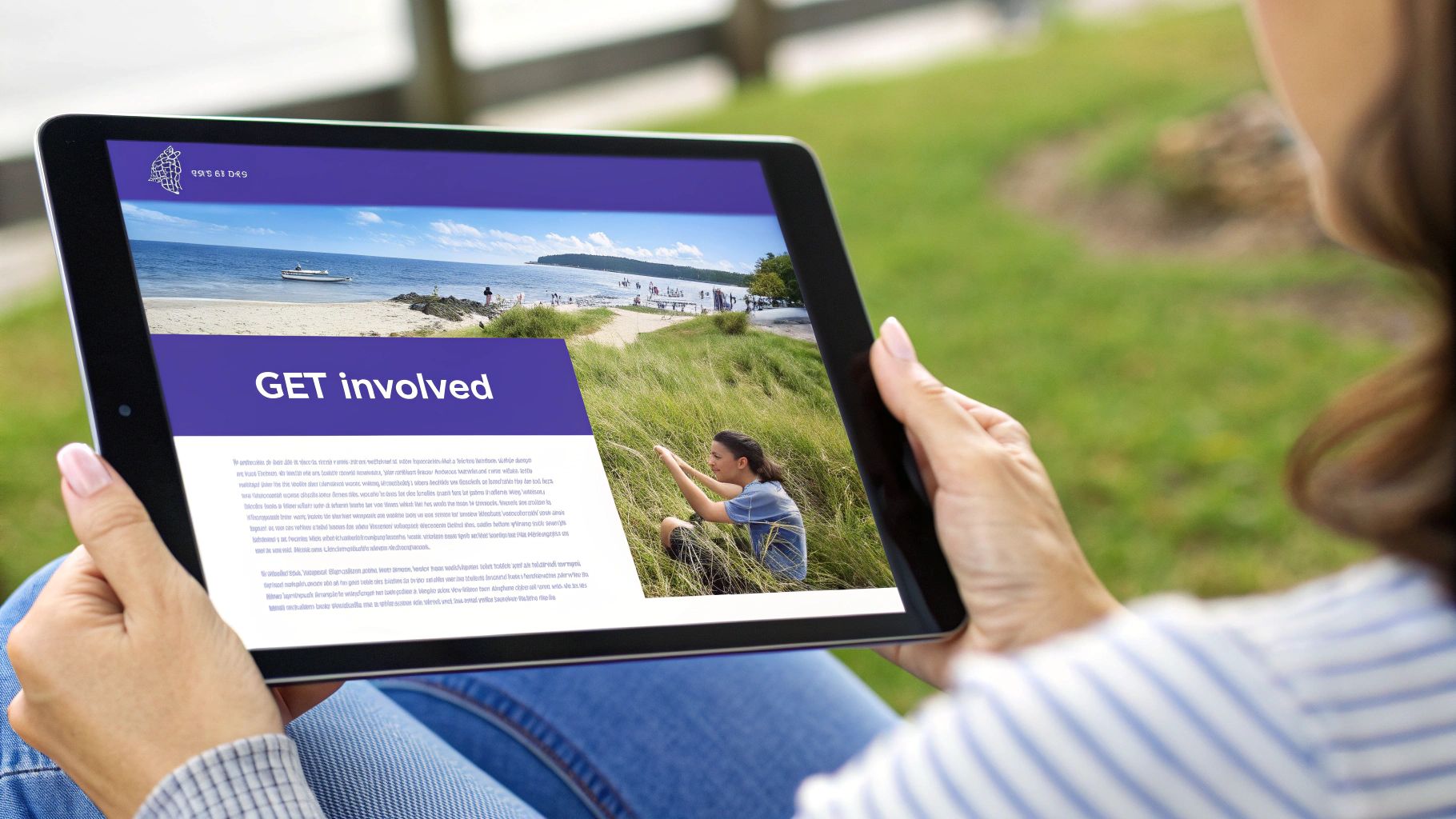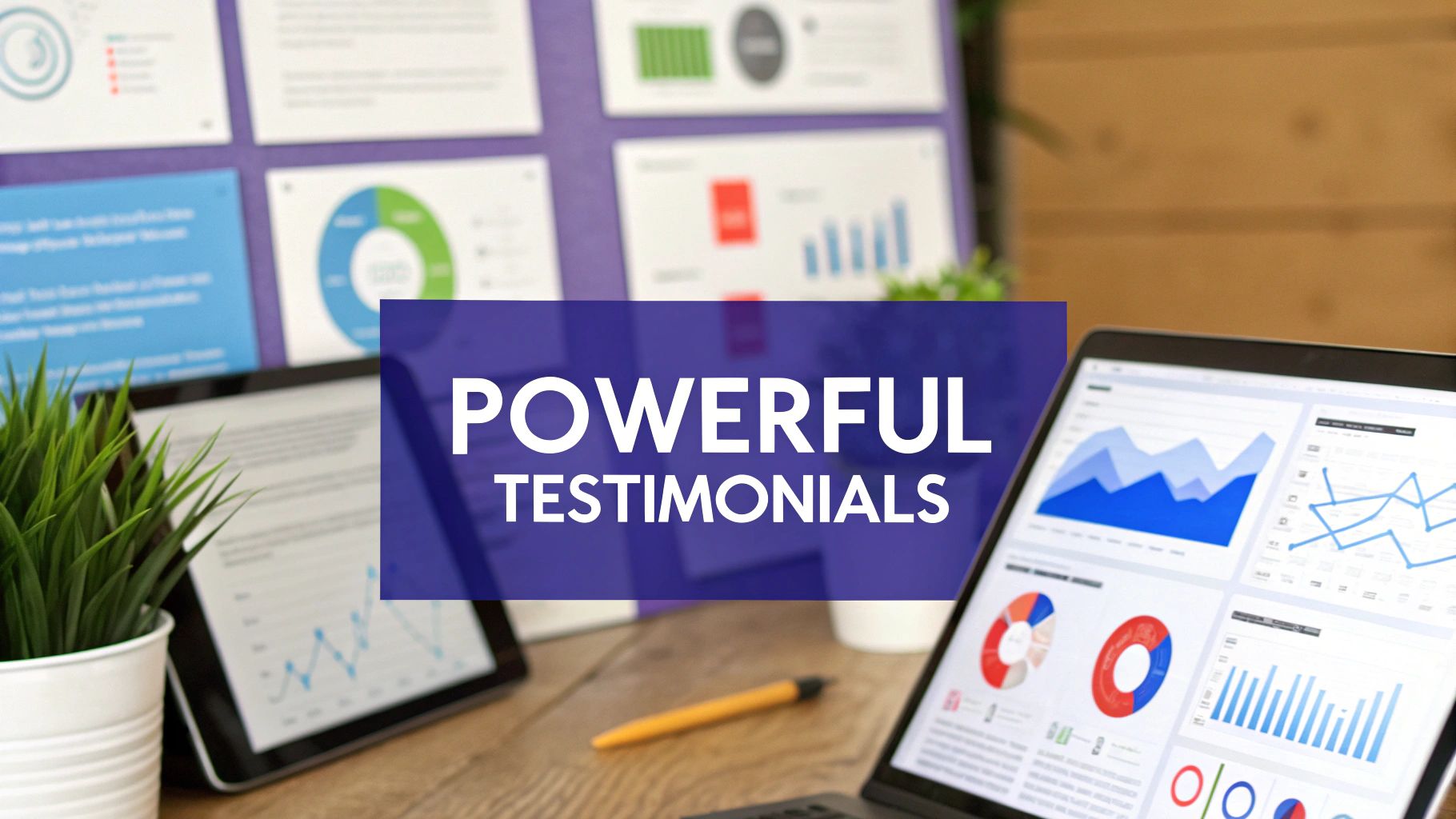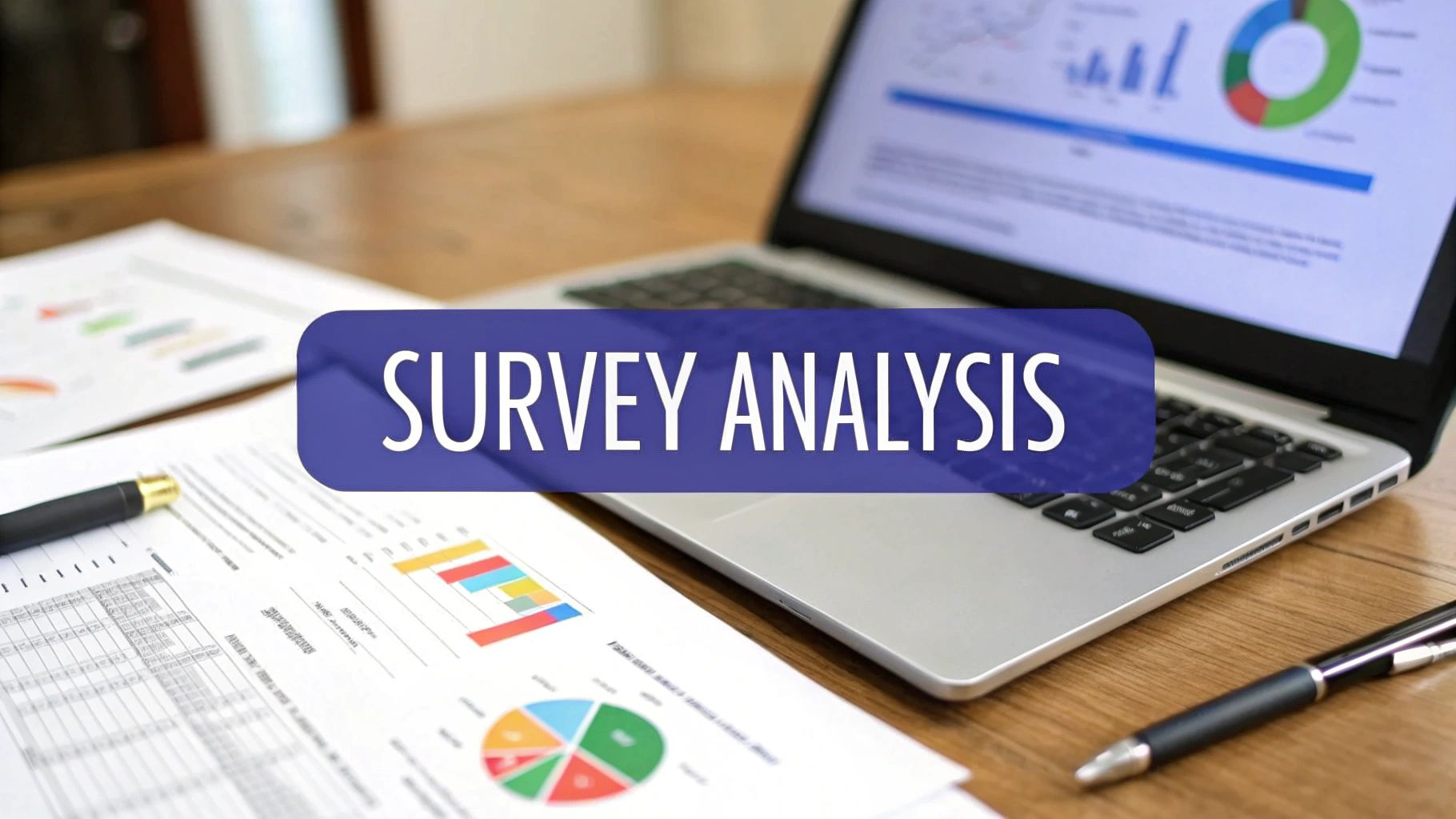The Anonymous Feedback Form Guide for Teams
Unlock honest insights with our guide to using an anonymous feedback form. Learn to build trust, boost performance, and improve team communication.

Let's be honest: getting feedback can be tough. It's even tougher to give feedback, especially when it's about something sensitive. That's where an anonymous feedback form comes in.
Think of it as a digital suggestion box, but with a crucial twist—it creates a space where people feel safe enough to share what's really on their minds, without worrying about judgment or negative consequences.
So, What Is an Anonymous Feedback Form Really For?
At its heart, an anonymous feedback form is a tool for building trust. It’s less of a survey and more of an open invitation for total honesty. When people know their identity is protected, they’re far more likely to share the difficult truths, the brilliant but off-the-wall ideas, or the sensitive concerns that would otherwise stay buried.
This simple shift from public, name-attached feedback to private, anonymous input is a game-changer. It breaks down the natural walls we put up due to office politics, org charts, or just the plain old fear of saying the wrong thing. What you get in return is a pure, unfiltered stream of information straight from the people who know your company culture or your product inside and out.
Fostering Psychological Safety
The number one job of an anonymous feedback form is to create psychological safety. This is that shared feeling that it’s okay to take risks and be vulnerable with your team. Without it, you get polite, agreeable, and ultimately useless feedback. Anonymity shatters that barrier.
- For Employees: It gives them a real opportunity to bring up concerns about management, team dynamics, or company policies without fearing they'll be labeled a "complainer."
- For Customers: It lets them share frustrations about your product or service that they might feel awkward attaching their name to.
This safety net unlocks a level of honesty that’s nearly impossible to get any other way, giving leaders a much clearer picture of their organization's true health.
"Providing an anonymous feedback option shows that you value honesty and are committed to improvement. This can build trust and boost morale among employees and customers."
Driving Genuine Improvement
Ultimately, you collect feedback to make things better. Anonymity supercharges this process by shining a light on the "unknown unknowns"—the hidden problems that are quietly draining morale, killing productivity, or pushing customers away. When you get candid feedback, you can fix the root cause, not just patch up the symptoms.
We’ve seen the impact of this at some of the world’s biggest companies. For instance, Google's famous annual anonymous survey, "Googlegeist," consistently gets an 88% participation rate. The raw feedback from that survey has sparked major changes, including a significant salary increase that former CEO Eric Schmidt initiated based on employee input.
It’s not just Google. Studies show that employees who take part in anonymous surveys report 20% higher job satisfaction compared to those in non-anonymous environments. And companies like Unilever have used these tools to slash employee turnover by 15%. The connection between anonymous insights and real business results is crystal clear. Find out more about the psychological impacts of anonymous surveys.
Here’s a quick rundown of the main advantages.
Core Benefits of Anonymous Feedback
Implementing anonymous feedback channels offers several key advantages that contribute to a healthier, more transparent organization. The table below summarizes the core benefits and their direct impact.
In short, anonymous feedback provides a powerful, unvarnished look into the reality of your business.
An anonymous feedback form isn't just another data-gathering tool. It’s a core piece of building a culture that’s transparent, resilient, and always getting better.
The Real Business Impact of Honest Feedback

Let's move beyond theory. The true value of an anonymous feedback form isn't just about good vibes—it's measured in real-world results. When you handle it right, the candid insights you gather translate directly into better business metrics. This isn't just about creating a positive atmosphere; it's a smart way to drive performance, innovation, and keep your best people around.
Think of it as a diagnostic tool for your company's engine. Without it, you might hear a faint, ignorable rattle. But with an anonymous form, your team can pinpoint the exact source of the problem before it causes a total breakdown. This kind of early warning saves time, prevents bigger headaches down the road, and keeps the whole operation running smoothly.
The connection between unfiltered feedback and business outcomes is incredibly direct, impacting everything from your team’s daily happiness to your company's bottom line.
Boosting Engagement and Slashing Turnover
High employee turnover is a killer. It's not just the cost of recruiting new people; it's the lost knowledge and productivity that really hurts. Anonymous feedback acts as a critical safety valve, giving employees a way to voice concerns before they fester into reasons for leaving.
When leadership actually listens and responds to this feedback, it sends a powerful message: your voice matters here. This simple act has a huge effect on engagement. People who feel heard are more invested, motivated, and committed. They shift from being passive bystanders to active players in the company's success.
Take Tech Innovate, a mid-sized tech company, as an example. They saw a 35% jump in employee engagement just six months after rolling out anonymous feedback tools. Before that, they were bleeding talent with a 20% annual turnover rate, driven by a culture of burnout. By analyzing honest feedback, leadership was able to adjust workloads and revamp their recognition programs. The result? Turnover dropped to just 12% the following year.
This story lines up with what the research shows: companies that use anonymity see real gains in team performance and innovation. You can discover more about the impact of anonymous feedback on engagement and how it builds trust.
Driving Smarter Product and Strategy Decisions
But the impact goes way beyond HR. For SaaS and product teams, an anonymous feedback form is a goldmine of unvarnished truth. Customers often hold back on negative feedback because they don't want to sound rude. Anonymity gives them the freedom to be brutally honest about friction points, confusing features, or what they really need.
These raw insights are exactly what product managers need to build a roadmap that actually solves problems.
- Uncover Hidden Friction: Find all the little annoyances in your UI that, when added up, create a frustrating experience your customers would never admit to in a public forum.
- Validate New Ideas: Get frank, unfiltered opinions on potential features from your beta testers before you sink thousands of dollars into development.
- Prioritize with Confidence: Figure out which bugs or missing features are truly wrecking user satisfaction, so you can put your resources where they’ll make the biggest difference.
A multinational corporation discovered that its biannual anonymous surveys led to a 25% increase in new product ideas submitted by employees. This just goes to show how creating a safe channel for ideas directly fuels innovation and growth.
When you connect the dots, it’s clear that an anonymous feedback form is far more than a simple HR tool. It’s a strategic asset that delivers a clear return on investment. By fostering a culture where honesty isn't just welcomed but actively sought out, you unlock a continuous stream of insights that drive performance, cut costs, and build a more resilient and adaptive organization.
How SaaS and Product Teams Can Use Feedback

While company-wide surveys have their place, the real magic happens when you point an anonymous feedback form at specific, high-stakes business challenges. For SaaS and product teams, anonymity isn't just a nice-to-have feature—it’s a competitive advantage. It unlocks the kind of brutal honesty you need to build a market-leading product.
These teams live in a world of rapid iteration and constant user testing. Polite, hesitant, or incomplete feedback can send them down the wrong development path, wasting months of work and thousands of dollars. Anonymity cuts through all that noise, creating a direct line to what your users and internal teams truly think.
Uncover Hidden User Friction
Imagine you’ve just launched a redesigned dashboard. Publicly, users might say it's "fine" or "okay" because they don't want to sound difficult. But privately? They’re getting lost, frustrated by a new workflow, and quietly checking out your competitors. An always-on anonymous feedback widget is perfect for catching these raw, unfiltered frustrations.
One SaaS company noticed a slight dip in user engagement after a big update but couldn't figure out why. Their anonymous feedback form, however, quickly revealed a recurring theme: users hated the new placement of a critical button. They found it completely unintuitive. It was a simple fix, but one they would have never discovered through traditional, name-attached support tickets.
By providing a channel for private complaints, you transform potential churn risks into actionable product improvements. Users who might have silently left are instead giving you the exact blueprint for how to make them stay.
This process allows product managers to find and stamp out all the small annoyances that, when added up, create a genuinely poor user experience.
Get Honest Opinions from Beta Testers
Beta testing is absolutely crucial for ironing out bugs before a public release. The problem is, beta testers—who are often your most loyal, early-adopter customers—can be hesitant to deliver harsh criticism. They don't want to damage their relationship with your product team. This politeness can lead to a feature launching with significant, unaddressed flaws.
An anonymous feedback form completely changes this dynamic.
- Brutal Honesty on New Features: Beta testers can freely admit if a new feature is confusing, useless, or just poorly designed without feeling like they're being overly negative.
- True Usability Insights: They can share detailed stories of where they got stuck or what felt clumsy, giving you a much more accurate picture of the real user journey.
- Unbiased Prioritization: Feedback gets judged on merit alone, not on which big-name customer it came from. This allows your team to prioritize the most critical fixes first.
This simple shift ensures that when a feature goes live, it's not just technically functional but actually solves the user's problem in a way that feels natural.
Improve Internal Development Processes
It’s not just about customers. An anonymous feedback form is also an incredibly powerful tool for improving your own team, especially during project retrospectives. After a stressful sprint or a challenging product launch, tensions can run high.
Developers or designers might hold back from voicing concerns about process bottlenecks, communication breakdowns, or leadership decisions in an open meeting. They might worry about being seen as uncooperative or creating conflict with their colleagues. This silence is what allows dysfunctional patterns to repeat, project after project.
Using an anonymous form for retrospective feedback lets team members share candid thoughts on what really went wrong and why.
- Were the project requirements unclear from the start?
- Was there too much pressure coming down from management?
- Did a specific tool or workflow slow everyone down?
This kind of frank input helps team leads identify and resolve the systemic issues that hurt productivity and morale. A study on post-training feedback found that allowing anonymous submissions is a best practice, as people are far more likely to provide honest feedback when their identity is confidential. By creating this safe space, you empower your team to fix its own processes, leading to faster, more efficient, and happier development cycles.
Right, so you're sold on the why of anonymous feedback. Now for the fun part: making it happen. Moving from theory to practice is where the real work begins. Creating and launching an effective anonymous feedback form isn't just a matter of picking a tool and hitting "publish." It's about designing a process that builds enough trust for people to actually participate.
Think of it like building a bridge. You need a solid technical foundation (the structure itself) and a clear, compelling reason for people to cross it (the cultural buy-in). A rickety-looking bridge won't see much foot traffic, and a feedback form that feels unsafe will just collect digital dust.
Designing Questions That Get Real Answers
The quality of the feedback you get is a direct reflection of the quality of your questions. The goal here is to get past simple "yes" or "no" answers and encourage people to share detailed, constructive thoughts. Vague questions will always get you vague feedback. It's as simple as that.
To pull this off, you'll want to use a smart mix of question types that dig for specific insights.
- Rating Scales (1-5 or 1-10): These are perfect for getting quantifiable data on things like satisfaction or agreement. For example, "On a scale of 1-10, how manageable is your current workload?"
- Multiple-Choice Questions: Great for spotting trends and segmenting your data. Think along the lines of, "Which of these areas do you think needs the most improvement? (Communication, Tooling, Work-Life Balance)"
- Open-Ended Questions: This is where the magic happens. Always, always include questions like, "What is one thing we could change to make your job more effective?" or "If you had a magic wand, what's the first problem you would solve at our company?"
One big mistake to avoid is asking leading questions that hint at the answer you want. "Don't you agree that the new software is much better?" is a terrible question. Instead, keep it neutral: "How has the new software impacted your daily workflow?" If you want to really nail your question design, exploring more strategies for effective feedback forms is a great next step.
Guaranteeing Anonymity and Building Trust
This part is non-negotiable. If anyone on your team even suspects their identity could be traced, the whole thing is a bust. You have to ensure total technical anonymity and, just as importantly, communicate those protections clearly and often.
This is the absolute cornerstone of encouraging people to participate. Studies consistently show that people are far more willing to give honest feedback when they know their identity is safe. It takes away the fear of judgment or blowback, which is the biggest hurdle to getting candid input. For a deeper look at the nuts and bolts, we have a whole guide on how to create anonymous surveys that put privacy first.
Here’s a quick look at the technical side of keeping feedback secure.

This process makes sure that the second a response is submitted, all personal identifiers are stripped away, the data is encrypted, and it's stored securely. It becomes impossible to link a response back to any individual.
Choosing the Right Tool for the Job
The tool you pick is the technical backbone of your entire feedback program. While a basic Google Form might seem easy, dedicated platforms offer much stronger security and way more useful features. When you're looking at your options, think about what your team really needs.
Choosing the right tool is a critical step, as different solutions are built for very different purposes. This table breaks down the common options to help you find the best fit.
Anonymous Feedback Tool Comparison
After comparing your options, you'll have a much clearer idea of which platform aligns with your goals for security, analysis, and user experience.
Crucial Tip: Before you launch, make a public statement about how the tool you chose protects user data. State it plainly: IP addresses are not tracked, and personal identifiers are not collected. This one act of transparency can do wonders for your participation rates.
At the end of the day, a successful anonymous feedback form comes down to a thoughtful approach. By carefully crafting your questions, making privacy a priority, and picking the right platform, you create a trusted channel that turns quiet frustrations and brilliant ideas into a powerful engine for improvement.
Turning Anonymous Feedback Into Action

Collecting insights through an anonymous feedback form is a great first step, but it’s only half the job. The real magic happens when you turn those raw comments into meaningful change. Without a clear plan to act, your feedback form is just a digital suggestion box collecting dust.
Think of feedback as raw ingredients. You can't just serve them as-is; you need a recipe to turn them into something valuable. This means you need a solid process for organizing, analyzing, and acting on what you've learned. A structured approach ensures no comment gets lost in the shuffle and that your efforts lead to real improvements.
This isn't just about managing complaints. It's about building a sustainable system for continuous growth. When people see their anonymous suggestions actually lead to tangible changes, they become much more invested in the process. That's how you keep a steady flow of high-quality insights coming your way.
From Raw Comments to Actionable Themes
The first thing you need to do is look for patterns. A single negative comment might just be an outlier, but five comments about the same exact issue? That’s a sign of a real problem. Your initial task is to categorize and tag the feedback to make sense of the volume.
For instance, you could create simple tags like "product-bug," "communication-issue," "workload-concern," or "feature-request." As you go through each submission, assign one or more tags. This simple step transforms a messy pile of opinions into a structured, usable dataset. Using a solid knowledge management system can centralize this feedback, making it way easier to spot those recurring themes and pull out actionable insights.
Once everything is tagged, you can start to quantify the feedback.
- Count the Mentions: How many times did "communication" come up this quarter?
- Track Sentiment: Is the feedback around the new UI mostly positive or negative?
- Identify Hotspots: Which department or product feature is generating the most comments?
This data-driven approach shifts you from simply reacting to anecdotes to strategically tackling the most pressing issues your team or customers have identified.
Handling Criticism and Closing the Loop
Let's be real: not all feedback will be positive, and that's the whole point. It's crucial to approach criticism with a constructive mindset. See it as a gift—it helps you see your blind spots. Instead of getting defensive, ask yourself, "What's the underlying truth here, even if it's phrased poorly?"
According to studies on post-training surveys, allowing for anonymous submissions is a best practice because people are far more likely to provide honest, critical feedback when their identity is confidential. This unfiltered input is vital for genuine improvement.
After you've analyzed the feedback and decided on a plan, the final—and most critical—step is to "close the feedback loop." This just means communicating back to your team or users about what you heard and what you’re doing about it. It shows their contributions truly matter.
For a more detailed walkthrough, our guide on how to analyze customer feedback offers a deeper dive into turning data into smart decisions.
A Practical Framework for Taking Action
Here is a simple, repeatable process for turning all that great feedback into real progress:
- Acknowledge and Thank: Regularly let people know you're reviewing their submissions and thank everyone for their input. This alone builds a ton of confidence in the system.
- Analyze and Prioritize: Use your tagging system to pinpoint the top 2-3 most urgent or frequently mentioned themes. You can't fix everything at once, so focus on what will deliver the biggest impact.
- Announce and Act: Publicly share the key themes you identified. For example: "We heard a lot of feedback about slow response times and confusing documentation. Here’s our plan to tackle these issues over the next quarter."
- Report on Progress: Follow up and show the results. "Three months ago, you told us our documentation was unclear. We've since rewritten our help center, and support tickets on this topic are down by 40%."
This cycle of listening, acting, and reporting transforms your anonymous feedback form from a simple tool into a powerful engine for building trust and driving cultural and product excellence.
Choosing the Right Anonymous Feedback Tool
Not all feedback tools are created equal. Choosing the right one is a bit like picking the right key for a lock—get it wrong, and you're stuck. But find the right one, and you’ll unlock a treasure trove of honest, game-changing insights. Your decision here directly impacts the quality of feedback you get and, just as importantly, whether your team trusts the process enough to even participate.
The market for anonymous employee feedback tools is booming, driven by new tech and evolving expectations from today’s workforce. Modern platforms are now blending sophisticated analytics with rock-solid privacy features to create a safe space for communication. Market studies show that tool selection often hinges on industry, company size, and even regional needs, with options ranging from cloud-based platforms to on-premise solutions. You can discover more insights about these market trends if you want to dig into the landscape.
When you're wading through the options, it’s easy to get distracted by flashy features that don’t actually solve your core problems. The real trick is to focus on the fundamentals that make an anonymous feedback form truly effective.
Core Features to Demand in Your Tool
Your absolute top priority should be finding a platform that nails three critical areas: robust privacy, insightful analytics, and a dead-simple user interface. A weak link in any of these can sink your entire feedback program before it even gets started.
Here are the non-negotiables:
- Guaranteed Anonymity: The tool must ensure every response is completely untraceable. This means no IP address tracking, no mandatory logins, and a crystal-clear privacy policy you can share with participants to build their confidence from day one.
- Insightful Analytics: Raw comments are a start, but a great tool helps you spot the patterns hiding in the noise. Look for features like sentiment analysis, keyword tagging, and dashboards that turn a mountain of text into clear, actionable themes.
- User-Friendly Interface: If the form is clunky, confusing, or just plain ugly, you'll lose people before they hit "submit." The experience has to be seamless and straightforward for everyone involved—from the person giving feedback to the admin reviewing it.
Matching the Tool to Your Goals
Beyond the core features, the best tool for you really depends on your specific goals and company size. A small startup has vastly different needs than a massive enterprise.
For instance, a great option for gauging team health is to run employee morale surveys. They are specifically designed to check the pulse of your team's satisfaction. On the other hand, a product team might get more value from an embedded website widget that captures real-time user reactions right in the moment.
Key Takeaway: The goal isn't just to buy software; it's to invest in a platform that aligns with your culture and strategic objectives. A tool that fits your workflow will see higher adoption and deliver much better results.
Your evaluation should also consider how you plan to ask questions. A good platform will support a mix of formats, from simple rating scales to detailed, open-ended questions. Mastering the art of phrasing these questions is a skill in itself, so be sure to check out our guide for some practical tips.
By carefully evaluating solutions based on privacy, analytics, usability, and your unique strategic goals, you can make an informed investment. Choosing the right tool is the first, and most important, step toward building a more resilient, adaptive, and transparent culture.
Got Questions About Anonymous Feedback?
Diving into anonymous feedback often brings up some practical questions. Let's face it, you want to get this right and avoid any common pitfalls. Getting clear answers is the best way to build confidence in the process.
Here are a few of the most common queries we hear.
How Can We Make Sure Feedback Is Truly Anonymous?
Real anonymity comes down to a mix of technology and trust. The smartest move is to use a dedicated third-party tool, like Surva.ai, which is built from the ground up to protect user privacy. These platforms are designed specifically not to track IP addresses or other personal details that could link a response back to a specific person.
But the tech is only half the battle. You also have to communicate this clearly. Tell your team or customers—over and over—how their anonymity is being protected. A simple, honest statement explaining that you're using a secure, specialized tool can make a world of difference for trust and participation.
It's a proven fact: people are way more likely to share honest, critical feedback when they know their identity is safe. Making that guarantee is the single most important step you can take.
What If We Only Get Negative Comments?
It's completely normal to see a wave of negative comments when you first roll out an anonymous feedback form. Don't think of this as a failure. Instead, see it as a release valve for pent-up concerns that people never felt safe enough to share before. That initial flood is a massive data point in itself.
Instead of getting discouraged, start digging for themes, even if they're wrapped in harsh language. Once you start addressing the constructive points and people see you acting on their feedback, the tone will naturally start to shift. Over time, just showing that you're listening will encourage more balanced and productive input.
How Often Should We Ask for Feedback?
There's no magic number here—the right frequency is all about your goals. But here are a few common rhythms that work well:
- For general team morale: A quarterly or bi-annual survey is usually a good tempo.
- For specific projects: Consider "always-on" forms or ask for input at key milestones.
- For product insights: A continuous feedback widget right inside your website or app is perfect.
Honestly, the schedule isn't as important as the consistency. Just pick a rhythm and stick with it. This shows everyone that feedback is an ongoing part of your culture, not just a one-off initiative.
Ready to turn honest feedback into real business growth? Surva.ai gives SaaS teams the AI-powered tools to collect, analyze, and act on user insights without ever compromising anonymity. Start building a stronger, more user-centric product today by visiting https://www.surva.ai.


